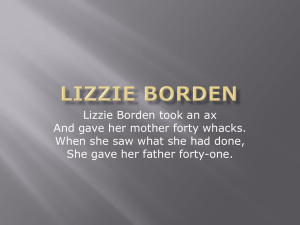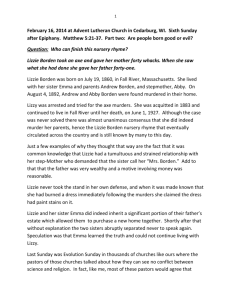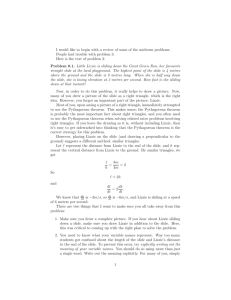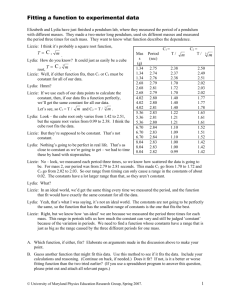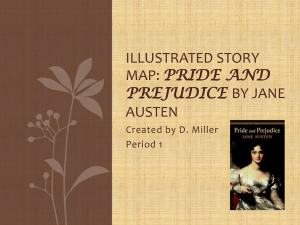Gloria Chao April 3, 2008 Fall River Legend:
advertisement
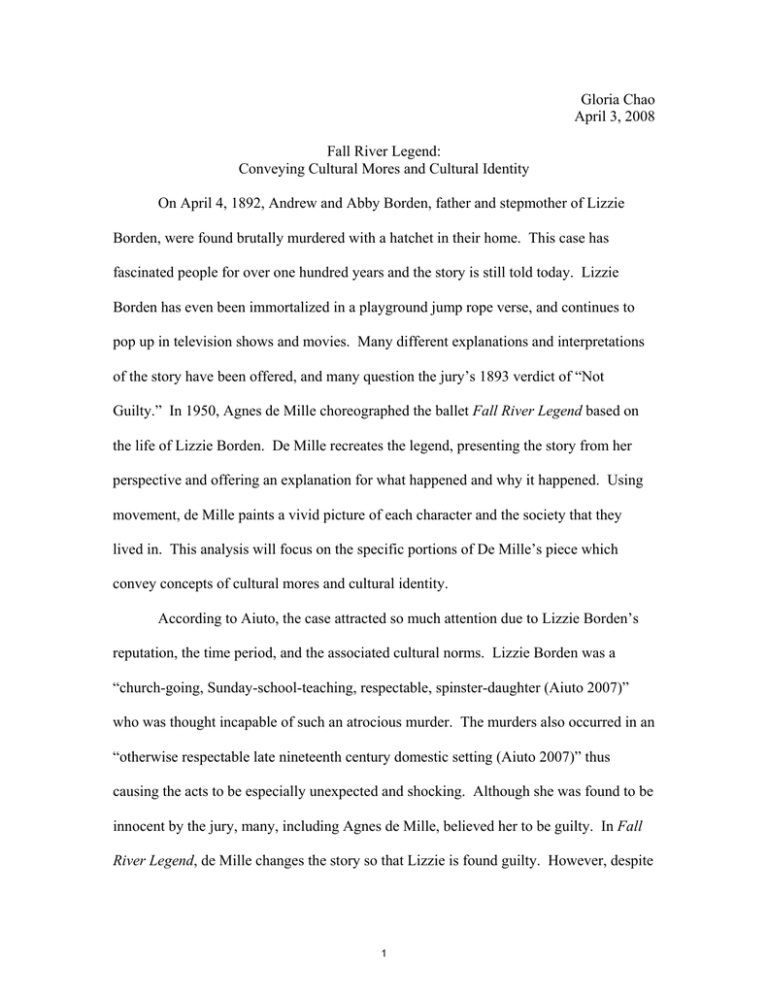
Gloria Chao April 3, 2008 Fall River Legend: Conveying Cultural Mores and Cultural Identity On April 4, 1892, Andrew and Abby Borden, father and stepmother of Lizzie Borden, were found brutally murdered with a hatchet in their home. This case has fascinated people for over one hundred years and the story is still told today. Lizzie Borden has even been immortalized in a playground jump rope verse, and continues to pop up in television shows and movies. Many different explanations and interpretations of the story have been offered, and many question the jury’s 1893 verdict of “Not Guilty.” In 1950, Agnes de Mille choreographed the ballet Fall River Legend based on the life of Lizzie Borden. De Mille recreates the legend, presenting the story from her perspective and offering an explanation for what happened and why it happened. Using movement, de Mille paints a vivid picture of each character and the society that they lived in. This analysis will focus on the specific portions of De Mille’s piece which convey concepts of cultural mores and cultural identity. According to Aiuto, the case attracted so much attention due to Lizzie Borden’s reputation, the time period, and the associated cultural norms. Lizzie Borden was a “church-going, Sunday-school-teaching, respectable, spinster-daughter (Aiuto 2007)” who was thought incapable of such an atrocious murder. The murders also occurred in an “otherwise respectable late nineteenth century domestic setting (Aiuto 2007)” thus causing the acts to be especially unexpected and shocking. Although she was found to be innocent by the jury, many, including Agnes de Mille, believed her to be guilty. In Fall River Legend, de Mille changes the story so that Lizzie is found guilty. However, despite 1 this, de Mille viewed Lizzie Borden as the victim in this whole mess, and communicated this perspective of Lizzie through the piece. She believed that Lizzie Borden began as the respectable, religious woman everyone perceived her to be, but was driven mad by her evil stepmother and the small-minded culture that she lived in. The society at the time was strict, with pre-determined roles and expectations for men and women, which de Mille successfully captures these concepts through her choreography. Fall River Legend begins on a dark, cloudy night, with dramatic eerie music, and nine dancers standing still. The only props onstage are the wooden gallows towards stage right and a black, leafless tree to stage left. Six of the dancers in the center of the stage are facing the front, legs apart and hands behind their back, looking straight ahead, with no expression on their faces. One dancer stands behind them, leaning with one arm against the wooden post of the gallows, the other arm behind his back. These are the jurors of the trail of Lizzie Borden. Off to the right hand side, a male, the pastor, and a woman, Lizzie Borden, are holding hands and looking at the six people in the center. The male dancers are dressed in dark colored suits, and the woman is dressed in a long dark green dress, with a black cloak and matching dark green hat. One dancer begins to speak, describing the murder in detail. The stillness of the characters and the words being spoken emphasize the brutality of the murders. De Mille selects harsh words and phrases to illustrate the violence. Some of these phrases include “assault,” “cut,” “strike,” “beat,” “bruise,” “20 mortal wounds,” and “instantly died.” The first movement that takes place occurs when the words “instantly died” are spoken. Lizzie swoons and falls into the arms of the man next to her, almost as if she cannot believe that her parents are dead, and cannot believe what she did. This implies that Lizzie is still in disbelief 2 that she could do such a thing and has not quite come to terms with it. Agnes de Mille uses this swoon to convey her thought that Lizzie is the victim, and that she was driven mad by the society she lived in. It is also important that Lizzie, the female, swoons, and is caught by the male standing next to her. During this time, female were viewed as delicate, graceful, weak individuals that needed to be saved, supported, and protected by males. Even after the murders have been committed and Lizzie is awaiting her verdict, she is still struggling with her cultural identity defined by society. De Mille continues this portrayal of men and women throughout the rest of the piece, with the men always supporting and catching the women, and with the women frequently falling and depending on the men. The man walks Lizzie to the center of the stage as the speaker announces that the jury finds Lizzie guilty of the murder. As soon as the speaker finishes, there is a dramatic change in the music, the pastor takes Lizzie’s hat and black cloak, and Lizzie faces the audience as she raises her right hand, fingers and palm outstretched. She has a bewildered look on her face, resulting from the realization that she has been found guilty of the murders. This causes Lizzie to appear more as a victim than a monster, reflecting De Mille’s perspective. There is then a transition to Lizzie’s childhood, when her mother is still alive and they are a happy family. This is when the cultural norms of the time period are first illustrated. All of the women are dressed in colorful, flowing dresses with matching hats with flowers. The only exception is Abby Borden, Lizzie’s stepmother, who is dressed in black. De Mille chose to do this to represent the evilness of Abby’s character. The townspeople are out, socializing and dancing together, illustrating the small-town 3 atmosphere and the fact that everyone knows each other. The women curtsy to the men, and everyone is polite, prim, and proper. Each gender has a role that they are expected to fit into, based on the way they dress, act, and interact with the opposite sex. The society as a whole is socially coercive and demanding. Lizzie and her parents fulfill their roles in society as mother, father, and daughter. Lizzie shows how she is depends on and loves her parents by holding their hands and placing her head on her mother’s outstretched hand, as if resting. Lizzie is obedient and listens to her parents throughout this scene. When the townspeople leave, Andrew Borden dances with his wife and with Lizzie, depicting the love and support he offers to both. The society at this time is further demonstrated in later scenes in the piece. Lizzie turns to the pastor for comfort, love, and support, demonstrating the importance of religion at the time. The church scene towards the middle of Fall River Legend further develops the small-town, socially coercive setting. All of the townspeople are attending church, and they all know each other, greeting one another warmly. The fact that everyone attends church emphasizes the large role religion plays in everyone’s lives. Religion implies that there were specified, and most likely strict, rules and regulations for everyone in society, the concept of which was touched upon earlier. Abby Borden’s character is defined early on, and she appears immediately after the transition to Lizzie’s childhood. The first time the audience sees her, she has a stern, unhappy look on her face, with her hands clasped in front of her, staring straight ahead. Her black outfit stands out among all of the bright colors. She greets Lizzie’s parents politely, but treats Lizzie cruelly. Her first interaction with Lizzie is behind her parents back, and she points her right index finger sharply at Lizzie with a stern expression on 4 her face, appearing to threaten her. She walks to stage right and pauses, looking to the left while stroking the left side of her face with her left hand, fingers curled. This movement eludes malice and gives the image that she is thinking malevolent thoughts. This becomes her trademark move throughout the piece, and she repeats it often. She begins to walk back and forth from stage right to stage left, walking slowly but deliberately while the rest of the town dances behind her. There is a sharp contrast between Abbey’s purposeful steps and the townspeople’s graceful waltz-like movements. She pauses between changing directions only to stare unkindly at Lizzie’s parents. When Lizzie’s mother falls into her father’s arms, Abby is there, pushing Lizzie away from her mother and preventing her from being near her parents. She repeats this twice, the second time hitting Lizzie on the arm first. She holds Lizzie’s mother’s hand, pretending to be compassionate, demonstrating how she hid her true character in the presence of Lizzie’s parents. When Lizzie’s mother passes away, Abby again prevents Lizzie from getting close to her mother, barricading the house door. She even grabs Lizzie and shakes her violently until Lizzie’s father pulls her away. Andrew Borden’s character is also defined early, first as a loving father as described above, and then as the weak-minded and negligent father he becomes when Lizzie’s mother dies. The transition occurs immediately after Lizzie’s mother’s death, and Andrew Borden grabs his head in anguish, his whole body shaking as his upper body repeatedly contracts so that it is rocking back and forth. He then reaches out to Abby, who stretches her arm out to him, and he runs to her, collapsing and embracing her around her waist. He leaves Lizzie by herself, who has fallen to the floor and is huddled in a heap of anguish and pain. Lizzie slowly gets up and faces Andrew and Abby, 5 clasping her hands and reaching towards them, but her father picks up Abby in his arms and brings her in the house, ignoring Lizzie. Lizzie is left alone to deal with her mother’s death and the loss of her father. Andrew, Abby, and Lizzie’s characters are further developed in the next scene, which takes place in 1892, after Lizzie becomes an adult. This scene focuses on how cruelly Abby treats Lizzie, and how Andrew has abandoned Lizzie for Abby. This, along with society, drives Lizzie to commit the murders. Andrew, Abby, and Lizzie are sitting in their house, with Andrew on the left, Abby on the right, and Lizzie in the middle. They are all sitting with their backs straight, very proper, as demanded by society. Lizzie reaches out first to her father, then Abby, but neither respond, and she stands up suddenly, puts her head in her hands frustratingly, and then looks up, pounding her fists as if helpless and exasperated. When Lizzie has her back turned, Abby leans forward and whispers something to Andrew, appearing to speak about Lizzie behind her back. When Lizzie turns around and glares at them, they return to being proper. When she tries to look out the window, Abby prevents her from doing so, storming over and pulling the drapes shut from behind her. Lizzie tries one last attempt to reach her father, kneeling before him and putting her arms around his neck, but Abby hurries over and throws Lizzie’s hands off. Andrew allows this and never responds to any of Lizzie’s attempts, emphasizing his weak-mindedness. Thus far, Lizzie has obeyed her parents because it is demanded by society, but she is beginning to go mad, which she demonstrates when she spins quickly away from her father after her last attempt to reach him. Once she stops, she puts her head in her right hand, breathing hard. This again shows frustration and helplessness. Cultural norms command Lizzie to obey her father and stepmother, but her 6 stepmother is evil and her father listens to everything his new wife says. She begins to go crazy from trying to obey people who treat her cruelly. Abbey comes over and taps Lizzie’s left temple with two fingers and then smiles wickedly, as if making fun of her and tormenting her. She then repeats her characteristic move of touching her face with her left hand, reminding the audience of her evilness. De Mille uses this scene to illustrate how society, along with Andrew and Abby are at fault for causing Lizzie to go mad, and that she is the victim. In this piece, there is an axe that Lizzie grabs three different times. Each of these instances represents a turning point in Lizzie’s character. The first time Lizzie grabs the axe Andrew and Abby are sitting down, proper, looking straight ahead. She steps out of the closet and pauses, facing front, legs spread apart, with the axe in her right hand. Andrew and Abbey jump up in fear and Andrew puts his right hand on Abby, as if to protect her, again demonstrating the cultural mores of the time. Lizzie looks at Andrew and Abby, looks at the axe, and then walks outside calmly and chops a block of wood, leaving the axe in the tree stump and carrying the split logs back into the house. They all sit down again, and Lizzie begins to laugh uncontrollably, symbolizing her craziness. However, as soon as she finishes laughing, she looks shocked, and brings her right hand to cup her face, almost as if she is in disbelief of what has just gone through her head. In this instance, Lizzie’s actions with the axe are calm and seem as if they were part of her every day routine. Andrew and Abby’s fear indicate that they have noticed Lizzie beginning to go mad, and fear for their lives. The second time Lizzie grabs the axe she is dancing by herself, outside, while her parents are inside, in the dark. The entire stage is darkly lit, giving an ominous, 7 foreboding feeling. She spins towards the axe and stops directly in front of it. She raises her hand forcefully as the music crescendos, but then gently lowers her hands to embrace the tip of the axe handle. She circles her upper body, head, and neck, as she continues to hold onto the axe, and then she begins slowly backing away from the axe, putting her hands over her heart and then on her waist, as if she was scared by her thoughts and emotions. She leans backwards, away from the axe, and slowly extends her arms towards the axe with her palms out, as if pushing the axe away. However, her palms quickly turn over and seem to draw her to the axe. She slowly walks towards the axe, as if it is pulling her in through her hands, but keeps her upper body leaning away from the axe. When she reaches the axe, she steps towards it and puts her right hand on it, but reacts as if it is hot, and she runs away, looking back a few times, before she falls on the ground, curled in a ball. Once she stands up, she pushes her hand towards the axe and leans back, with her eyes closed. This clearly illustrates the conflict that Lizzie feels, and shows how she is struggling with her thoughts. She is drawn to the axe, but is trying to resist its pull. This suggests that Lizzie was the victim, pushed to madness by society and her evil stepmother. This scene demonstrates that she tried to resist in the beginning, but could not in the end. The third and final time Lizzie grabs the axe, she walks deliberating and confidently towards it, wearing a white shawl. She grabs the axe forcefully and with purpose, and hides the blade within her dress. She walks confidently back in to the house, turns towards the audience, and screams, covering her mouth with her hands, fingers outstretched. By using these three instances of grabbing the axe, De Mille 8 brilliantly illustrates the change in Lizzie’s character over time, tracing how and when she went mad. Through Fall River Legend, Agnes de Mille narrates a story that has continually fascinated the public and weaves her own perspective and interpretations into the piece. She clearly illustrates the cultural mores of the time and the expected roles of each gender. She demonstrates the delicacy and dependency of the women on the strength and support of the men. She conveyed the wickedness of Abby Borden, and communicated that she believed Lizzie was driven mad by society’s demand to obey her parents, regardless of how poorly she was treated. Though Lizzie was viewed as a monster by many, De Mille presents Lizzie Borden as a victim, driven mad by society’s demand to obey the cultural mores. 9 References Aiuto, Russell. “Lizzie Borden Took An Axe.” Crime Library: Criminal Minds and Methods: 2007. 25 March 2008 <http://www.crimelibrary.com/notorious_murders/famous/borden/index_1.html>. 10 MIT OpenCourseWare http://ocw.mit.edu 21M.670 / WGS.591J Traditions in American Concert Dance: Gender and Autobiography Spring 2008 For information about citing these materials or our Terms of Use, visit: http://ocw.mit.edu/terms.

